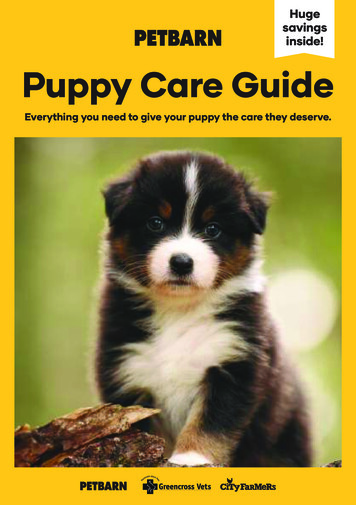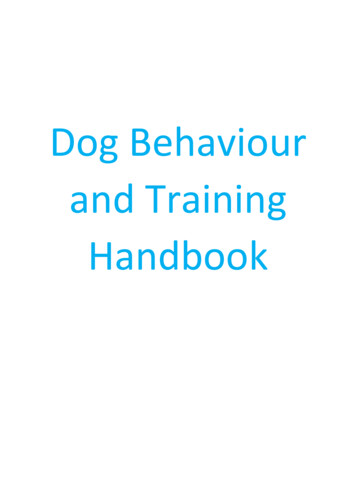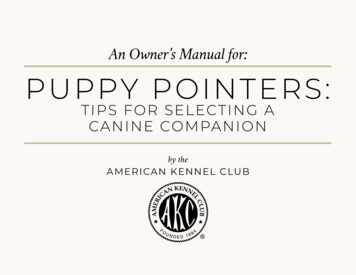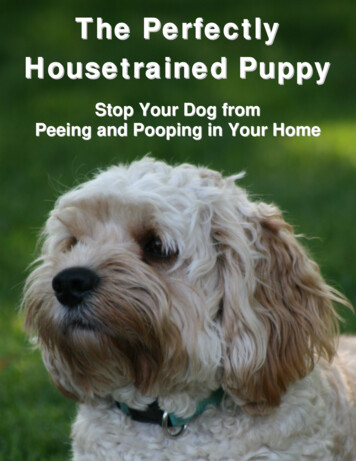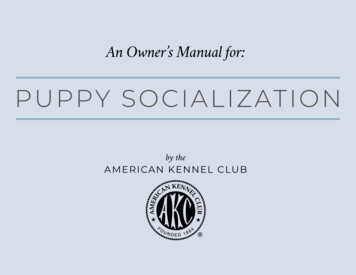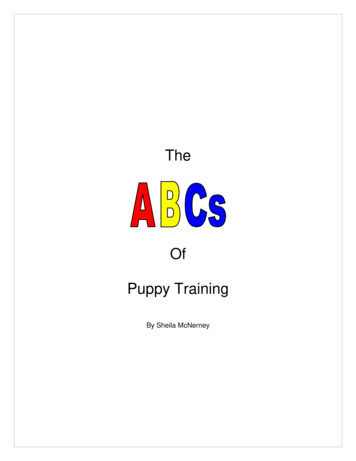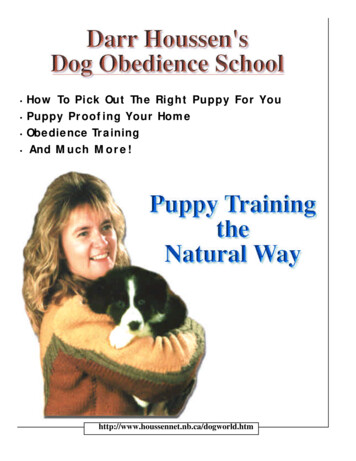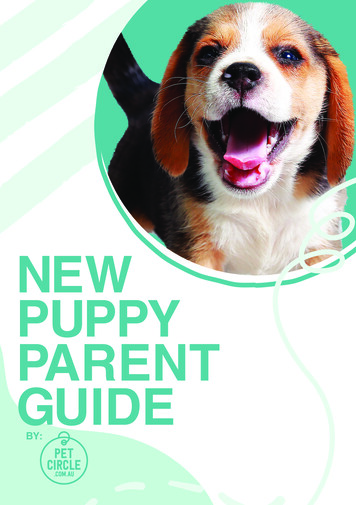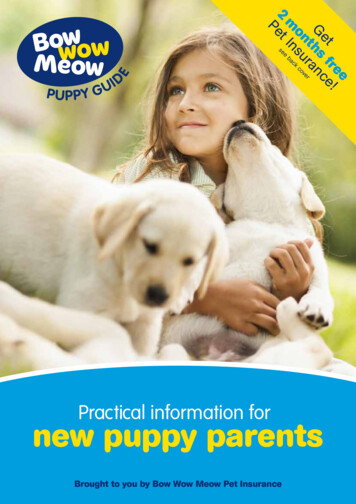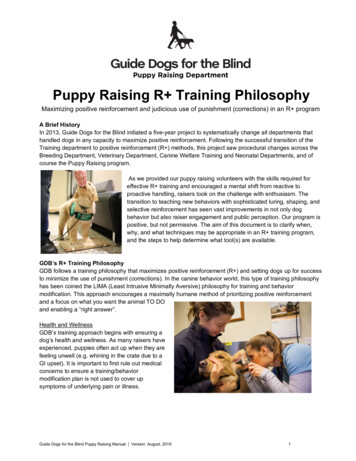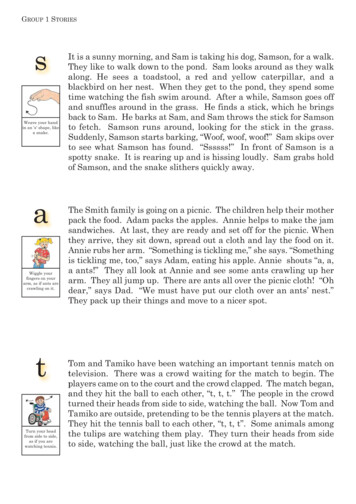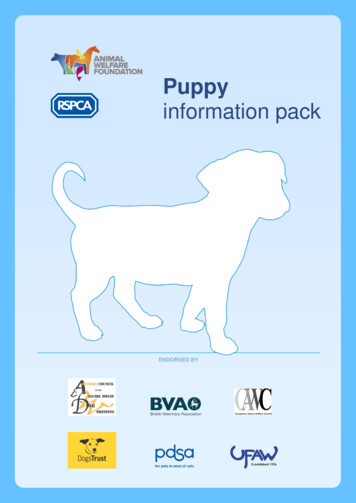
Transcription
Puppyinformation packENDORSED BYPAGE 1 OF 16
About the breeder1.Contact detailsTitleForenameSurnameAddressPost codeTelephoneMobileEmail About the seller (if different)2.Contact detailsTitleForenameSurnameAddressPost codeTelephoneMobileEmail About the puppy3.Date of birthDD/MM/YYYY4.Sex:5.Colour/distinguishing marksMaleFemalePlease describe6.Is the puppy a specific breed?YesNoState breed7.Is the puppy a cross-breed?MotherYesNo State breed(s) for each parent if known:FatherPAGE 2 OF 16
8.Is the puppy registered?YesNoType of registration, e.g. Kennel Club, The Greyhound StudbookRegistration numberPuppy‟s registered name9.Is the puppy subject to any Kennel Club endorsements?YesNoIf yes, state endorsements placed10.Has the puppy been microchipped?YesNoChip number (15 digits)11.Is the puppy covered by a breeder’s insurance policy?YesNo If yes, state:Insurance companyPolicy numberPolicy expiry date12.Was this puppy born by caesarean section?13.Will the puppy be vaccinated before it is sold?YesNoYesNoIf yes, attach vaccination record to the PIP and insert next vaccine due date.14.Give details of any worming treatments the puppy will have receivedProduct used15.Will the puppy’s tail have been docked?DateYesIf yes, will a signed docking certificate be attached to the PIP?16.NoYesNoIf the puppy has had a health check or been treated by a vet for anyreason prior to the sale please tick this box and provide further detailsTreatment/check dateTreatment/check provided (if further space is needed use Question 44: extra information)PAGE 3 OF 16
17.What is the puppy’s current weight?Kilograms and grams18.Date weight recordedWhat types of diet is the puppy currently being fed?DryPouch/tinnedFrozenAmount fed per day (grams). If morethan one type state how much of each.Approximate times of day when the puppy is fed19.Will the buyer be given enough of the puppy’s current food for at least five days?20.Will toilet training be started before sale?YesYesNoNoIf yes, where will the puppy be trainedto toilet, e.g. outside on grass?21.Where is the puppy kept for the majority of the time?In a kenneIIn a quiet part of the houseIn a part of the house where there is a lot of activity (e.g. kitchen)Other (please describe)22.Before the sale will the puppy have interacted with:Adult malesAdult femalesChildren under 4 yearsChildren between 4 and 10 yearsChildren over 10 years23.Will the puppy have interacted with:Other dogs of the same breed or typeDogs of different breeds or typesCatsRabbitsOther animals, state which24.Will the puppy have experienced:Wearing a collar or harnessBeing briefly separated from his/her mother and littermates in the company of peopleBeing in a restricted environment. For example, an indoor kennel.Hearing household noises. For example, washing machine, vacuum cleaner*Hearing real or recorded noise. For example, fireworks or traffic**Describe these experiences, e.g. washing machine, traffic noise:PAGE 4 OF 16
25.Before the sale will the new owner have the chance to see and interact with:The puppy‟s motherThe puppy‟s fatherOther puppies in the litter About the puppy’s mother26.Date of birthDD/MM/YYYY27.Has the mother been microchipped?YesNoChip number (15 digits)28.Is the mother registered?YesNoType of registration, e.g. Kennel Club, The Greyhound StudbookRegistration number29.How many caesarean sections has the mother had, including this litter?30.How many litters has the mother had, including this one?31.How old was the mother when she had her first litter?Years and monthsWas it on her first season?Yes32.Is the mother up to date with UK vaccinations?33.When was the mother last treated for worms and which worming product was used?YesNoProduct used34.Has the mother had any surgical procedures to correctfeatures that could be inherited by the puppy?YesNoDateNoIf yes, pleasegive detailsPAGE 5 OF 16
About the puppy’s father35.Owner’s name and addressTitleForenameSurnameAddressPost codeTelephoneMobileEmail36.Father’s date of birthDD/MM/YYYY37.Has the father been microchipped?YesNoChip number (15 digits)38.Is the father registered?YesNoType of registration, e.g. Kennel Club, The Greyhound StudbookRegistration number39.Has the father had any surgical procedures to correctfeatures that could be inherited by the puppy?YesNoIf yes, pleasegive details40.Is the puppy’s pedigree known and will its pedigree certificate be attached to the PIP?41.What is the relationship between the puppy’s parents?YesNoThird degree relatives (first cousins)Distantly related (e.g. second or third cousins)UnrelatedUnknown42.How inbred is the puppy? See guidance notes for help.Enter COI or leave blank if unknownPAGE 6 OF 16
43.Inherited conditions and screening/DNA testsThis section should be completed to note common or serious inherited conditions in the breed(s) and to record any related screeningor DNA tests conducted on the puppy and its parents.Breeders and owners should refer to the guidance notes for where to find information on canine inherited disorders.Information should be completed: For the mother if she is a specific breed or a cross between two specific breeds For the father if he is a specific breed or a cross between two specific breeds which are different to the mother If the puppy is a specific breed and tests have been carried outMother’s breed(s)Common or serious Screening orinherited conditions DNA testin breedavailableTest carried outDate of testResultsavailableResultscertificategiven to YesNoIf testing carried out and results notavailable or if testing not applicableplease state whyFather’s breed(s)Common or serious Screening orinherited conditions DNA testin breedavailableTest carried outDate of testResultsavailableResultscertificategiven to YesNoIf testing carried out and results notavailable or if testing not applicableplease state whyPuppy’s breed(s)Common or serious Screening orinherited conditions DNA testin breedavailableTest carried outDate of testResultsavailableResultscertificategiven to YesNoIf testing carried out and results notavailable or if testing not applicableplease state whyPAGE 7 OF 16
44.Extra information. Use this space to include any additional information about the puppy. AWF and RSPCA 2013. You may download, print and copythis document but you must not modify it without our priorwritten permission or sell or republish it.PAGE 8 OF 16
Puppyinformation packGuidance notesENDORSED BYPAGE 1 OF 16
Q1 & Q2: About the breeder/sellerAWF and the RSPCA recommend that you do not buy apuppy from anyone other than the breeder so that youcan see the puppy in the place where he was born.Q9: Is the puppy subject to anyKennel Club endorsements?Before a puppy is sold the breeder may apply to theKennel Club to place endorsements on its recordsincluding the registration certificate. For example,R – PROGENY NOT ELIGIBLE FOR REGISTRATION orX – EXPORT PEDIGREE NOT ALLOWED.The breeder must explain what the endorsements meanbefore you agree to buy the puppy.Q10: Has the puppy been microchipped?Microchipping helps puppies to be identified and returnedif they get lost or stolen. If the puppy you are buyinghas already been microchipped you must contact therelevant registration scheme to update their recordswith your contact details. If not, you should get yourpuppy microchipped.Q11: Is the puppy covered bya breeder’s insurance policy?Breeders often insure their litters. Some insurancepolicies provide free cover for new owners against apuppy‟s illness or injury for a limited period afterpurchase. Check the details.Q13: Will the puppy be vaccinatedbefore being sold?Vaccinations are very important to prevent certain deadlydiseases such as parvo. If the mother was vaccinatedproperly the puppy should have resistance to thesediseases for roughly the first ten weeks of its life. If yourpuppy has been vaccinated the breeder‟s vet will havegiven them a vaccination certificate which shows thevaccination date and products used. Speak to your vetabout whether the puppy requires any more vaccinationsand when its first booster is due.Q14: Details of worming treatmentsthe puppy will have receivedRegular worming is important for all puppies, whether themother was wormed or not, for the health of puppies andhumans. Ask your vet about the products listed and avoidbuying from breeders who have not treated their dogs forworms at all.Q15: Will the puppy’s tail have been docked?Tail docking involves removing a puppy‟s tail either bycutting it off or using a tight rubber band to make it die.The AWF and the RSPCA are firmly opposed to thepractice unless the tail is injured or diseased. It causespain and even death in some puppies and can causelong-term health problems. It can also reduce how welldogs can communicate with each other.The law bans tail docking in England, Wales andNorthern Ireland except under certain conditions and onlywhen performed by a vet. There is a total ban in Scotland.Q12: Was this puppy born by caesarean section?AWF has a leaflet which explains the rules on tail dockingin the UK. The leaflet can be downloaded from: www.bvaawf.org.uk/advice-vetsA caesarean section is an operation to take the puppiesout of the mother when she hasn‟t been able to give birthnaturally. It is a major operation which can causeproblems for the mother and puppies.If the puppy has been docked legally you should be givena certificate signed by the vet who did the docking.Some breeds and some individual mothers struggle togive birth naturally and may end up needing acaesarean every time. Vets feel that these dogs shouldnot be bred from. So you should avoid buying puppiesfrom mothers who have had more than one caesarean.This is especially important if the puppy is a female youwant to breed from, otherwise she may have troublegiving birth herself.Q16: Has the puppy had a health check or beentreated by a vet for any reason?Many puppies don‟t need to see a vet before they leavetheir breeder. If your puppy has been checked or receivedany treatment the breeder should provide details ofanything abnormal that the vet noted. Talk to your vet ifyou are unsure about any of this information.It‟s best to get your puppy examined by your vet as soonas you can, to make sure there are no problems straightaway and to get advice about things like food,vaccination, worming, fleas, insurance, microchipping,neutering and socialisation.PAGE 10 OF 16
Q17: What is the puppy’s current weight?There is no single correct weight for a puppy. However,it‟s really useful to know how much the puppy weighedwhen you got him so that your vet can see if he gainsor loses weight.Q18: Details of the puppy’s dietIt is important that you know the type of food that thepuppy is used to and how often and when he is usedto being fed, so that these can all be kept as similar aspossible when you take the puppy home. Puppiesshould be fed a weighed or measured amount of foodat regular times.Q19: Will the buyer be given enough of thepuppy’s current food for at least five days?When changing to a new food, this should be done overfour to five days with increasing amounts of the newfood replacing the previous food each day. If the foodis changed too rapidly, this can cause stomach upsetor diarrhoea.Q20: Will toilet training be started before sale?Puppies start to learn a preference for the surface thatthey toilet on at an early age. The more they toileton a particular surface, the stronger this preferencebecomes. You can then continue training the puppy in asimilar way, or expect to be really patient and consistentif you wish to change their preference.Seek a professional trainer to help you with furthertraining of your puppy (www.abtcouncil.org.uk )Q21: Where is the puppy keptfor the majority of the time?It is well documented that the early social and physicalenvironments of puppies strongly influences theirbehaviour as adults. A puppy that has lived in a domesticenvironment, particularly in a part of the home wherepeople come and go, is more likely to be prepared for lifein a home. Where puppies are kept in kennels, you needto check that they have experienced aspects of a normalhome environment at least some of the time.When you visit the puppy ask to see where he has beenkept. Although you may be introduced to the puppy in ahouse, he may not usually be kept there. Are there foodbowls, bedding, pens, etc?Q22: The puppy’s experienceof contact with peopleThe first 12–14 weeks of a puppy‟s life are very importantin determining how he will react to people. Lack of socialcontact during this period increases the risk of behavioursassociated with fear and/or anxiety later in life.Puppies need to have contact with men, women andchildren during this period. In general the more peoplethat puppies have interacted with the better.Puppies which have had positive experience of lots ofdifferent types of people are less likely to be warywhen you handle and approach them. Ask the breeder ifyou can take as many members of your family aspossible when visiting. Watch carefully how the puppyresponds to adults and children acting normally/reasonably. Look for signs of the puppy withdrawing,struggling to get away, cowering, putting their tailbetween their legs or hiding.Q23: The puppy’s contact withadult dogs and other animalsPuppies need to meet a variety of other dogs in order tolearn social skills and how different types of dogcommunicate. If the puppy is vaccinated ask to see himinteracting with adult dogs other than his mother so youcan see if he is confident and happy to interact and playwith another dog.If puppies have experience of other animals, they will bemore likely to adapt rapidly to any other animals theyhave to live with in your home. If the puppy is very excitedor nervous with other animals, he will be more likely toshow these behaviours with other animals when you takehim home.If possible see what other animals are in the environmentwhere the puppy lives and watch how he reacts to them.Q24: The puppy’s other experiencesEarly exposure to a range of experiences and noisesprepares the puppy for encountering this later in life so heremains calm and is less likely to be afraid when you takehim home.Watch how the puppy responds to things that arehappening during your visit. Ask the breeder to show youhow the puppy reacts to household noises, wearing acollar, or being separated briefly from littermates. Heshould remain calm during each.Do not expose him to sudden new noises that he has notexperienced before or expect the breeder to do so.PAGE 11 OF 16
Q25: Before the sale will the new owner havethe chance to interact with the puppy’s parentsand other puppies in the litter if there are any?It is very important that you see the puppy‟s mother andthe other puppies in the litter. You should also try and seethe father if possible, although this may be difficult insome circumstances. Make sure you interact with theparents, handle them if safe to do so, and assess theirreaction to you. Check they appear healthy, check theenvironment that the mother and puppies are in andcheck the temperament of the mother, father and otherlittermates. The parents‟ characteristics can influencehow the puppies develop and behave. In particular, lookfor signs of fear, such as withdrawal, cowering, urination,and tail between the legs. Also watch for signs ofaggression such as growling, lunging and barking.Unscrupulous breeders can try and show you anotherdog instead of the puppy‟s mother. To avoid this makesure you see the mother and puppies together, and checkfor signs that the dog you see has given birth recently,such as having enlarged nipples. Ask why otherlittermates or father cannot be seen if breeders answer„no‟ in these sections.Q30: How many litters has the mother had,including this one?Pregnancy, birth and rearing puppies all take a lot ofenergy and work for any mother. She may have problemssuch as difficulty giving birth and poor body condition ifher nutritional needs aren‟t met. Mothers should beallowed at least one season between litters. Avoidpuppies from mothers that have had numerous litters, asthis may be a sign that the breeder has expected toomuch from the mother and may also mean that the careand condition of the puppy might not be ideal either.Q 31: How old was the mother when she had herfirst litter and was it on her first season?Responsible breeders should not breed from their bitch‟sfirst season and should not breed from bitches underabout one year old. This makes sure the mother is fullygrown, mature and is as capable as possible of copingwith pregnancy and birth. Breeders who have ignoredthese laws or guidelines may not be very knowledgeableand caring about the mother, and therefore the puppy.deadly diseases. This will keep them healthy until theycan be vaccinated themselves. Homeopathic vaccinesshould NOT have been used. Ask your vet if you areunsure what vaccines she should have had.Q33: When was the mother last treated for wormsand which product was used?Regular worming of the mother, including duringpregnancy, is important to make sure the puppies arenot born infested with worms. Ask your vet about howeffective the products listed are, and whether they are upto date. Avoid buying from breeders who do not vaccinateor worm their animals adequately.Q34 & Q39: Has either parent had anysurgical procedures to correct featuresthat could be inherited by the puppy?Many breeds have been bred to emphasise certainfeatures which over time have become more and moreexaggerated. Although “normal” for a breed, flat faces,heavy wrinkles and very floppy ears are just a fewexamples of features that may cause problems.For example, dogs with short flat faces often have narrownostrils and tiny windpipes. They can suffer severebreathing difficulties and may even have difficultyenjoying a walk or playing. Folded or wrinkled skin maybe itchy and painful, and infolding eyelids can scratch theeye ball. Some of these problems will require lifelongmedication or sometimes surgery.You should also be told if either parent has had surgery tofix a problem such as eyelids which rubbed on the eye asthis may no longer be obvious to see, but could still beinherited by the puppy.It‟s important to know whether the parents are affected togive you an idea of how likely the puppy will be to get thesame problems. Speak to your vet about any problemslisted.Before you buy a puppy find out which breeds are worstaffected and try to avoid them. To find out more talk toyour vet or visit the following websites: Canine Inherited Disorders Database:www.upei.ca/cidd Get Puppy Smart: getpuppysmart.com/exaggeratedfeatures factsheetQ32: Is the mother up to date with UK vaccinations?It is very important that the mother‟s routine vaccinationsare up to date. She needs to be vaccinated to make sureher puppies are born with a good immunity to certain Dog Breed Health: www.dogbreedhealth.com/Breeders can also ask their vet and should use thewebsites above when listing the exaggerated featuresin their breed.PAGE 12 OF 16
Q35: Contact details: owner of the puppy’s fatherThis information can only be included if the owner hasgiven permission for their contact details to be sharedwith a prospective owner.Q40: If the puppy’s pedigree is known anda pedigree certificate will be attachedThe pedigree certificate shows the puppy‟s ancestry andmay go back up to five generations, starting with thepuppy‟s parents in the left column through to the greatgreat-great grandparents on the right column. The tophalf shows the puppy‟s ancestry through its father and thebottom half is the mother‟s pedigree. You can see anexample of a certificate here.Q41: What is the relationshipbetween the puppy’s parents?If the puppy‟s parents are related to each other then thepuppy is inbred. The degree of inbreeding depends onhow closely related the parents are. If an ancestor‟s nameis repeated in both the father‟s and the mother‟s halves ofthe pedigree certificate then there is inbreeding.Inbreeding is not desirable as it increases the risk ofinherited disease. Avoid a puppy from matings betweenfirst or second degree relatives e.g. First degree – mother/son, father/daughter,brother/sister Second degree – uncle niece, aunt/nephew,grandparent/grandchildPuppies whose background is not known cannot havea score calculated and in these cases the box will beleft blank.The COI for Kennel Club registered puppies (andtheir parents) can be found using Kennel Club‟s MateSelect /mateselect/Default.aspxYou can also use Mate Select to find out the average COIfor particular breeds.Q43: Inherited disorders and screening testsInherited disordersMany breeds of dog are prone to a number of inheriteddisorders. Pedigree dog registration and showing rulesmean that breeds not only look different but they alsohave higher likelihoods of developing particular disorders.Crossbred dogs can also inherit disorders from theirparents‟ breeds.Some inherited conditions are very rare or cause onlyminor suffering, whilst others are extremely painful or lifethreatening. Examples of inherited disorders are cancer,blindness, diabetes, heart disease, skin complaints,epilepsy, hip dysplasia and deafness.It is important to be aware of these conditions as theycould have been passed on to the puppy.Talk to your vet before you buy and check for informationon inherited disorders on the following websites: University of Cambridge Inherited Diseases in DogsDatabase: www.vet.cam.ac.uk/ididQ42: How inbred is the puppy? The Kennel Club: www.thekennelclub.org.uk/item/570It‟s important to avoid buying puppies that are very inbredbecause they have a higher chance of having inheriteddiseases and being unwell later in life. A simple way todescribe this is the Coefficient of inbreeding (COI). This isa number where the higher the number, the more inbredthe puppy. Universities Federation for Animal Welfare:For example, a very inbred puppy would come from amother to son mating or a brother to sister, both having aCOI of 25. A less inbred puppy might come from a matingbetween a great-grandfather and great-granddaughterwith a lower score of 6.25. Inbreeding can also build upthrough generations so if a pedigree goes back a longway very high scores (over 25) can occur.Puppies with a COI over 12.5 should be avoided.www.ufaw.org.uk/dogs.php Dog Breed Health: www.dogbreedhealth.com/ Canine Inherited Disorders Database:www.upei.ca/cidd University of Sydney: www.vetsci.usyd.edu.au/lida Some Breed Club websites also report common andimportant inherited conditions in the breed.DNA and health screening testsSeveral health screening tests are available to measurethe risk that a dog will be affected by the disease, be acarrier (and able to pass it on to their offspring) or beunaffected.PAGE 13 OF 16
The breeder should have listed important disorders whichcan be screened for in the puppy and its parents andattached copies to the PIP of the results certificates forany tests carried out. If the puppy is a cross between twoknown breeds the list should include conditions found ineach of those breeds. If the breeder has stated that theyhave not done the tests or that the results are notavailable you should ask why – and avoid buying a puppyfrom them.Do not be satisfied with word of mouth; make sure yousee the test results. If you buy from a breeder who hastested their dogs and is breeding from those that havepassed the health tests you will be another step closerto a happy, healthy puppy.Information on the British Veterinary Association/ KennelClub (BVA/KC) Health Screening schemes and adviceon how to interpret the results is available from:www.bva.co.uk/atoz/Canine Health Schemes.aspxIf the puppy‟s parents are Kennel Club registered and youknow the KC registered name or number of the parents,then test results from a BVA/KC health scheme or aKennel Club DNA testing scheme can be found select/test/Default.aspxA list of all canine DNA tests available worldwide can befound ion detail&id 8288Your vet can help you understand the results of DNA orhealth screening tests and give you advice on which testsare important for particular breeds.Q44: Extra informationAdditional information about the puppy can be recorded inthis space.Disclaimer: The contract, puppy information pack and related documents are intended to provide a fair basis for thesale and purchase of a puppy with the primary aim of promoting animal welfare.No warranties, representations or undertakings are made about the documents (including without limitation any asto quality, accuracy or fitness for any particular purpose). The AWF and RSPCA cannot accept liability for any lossarising out of or in connection with the use of these documents. A suitably qualified lawyer should be consultedon any specific legal issue. AWF and RSPCA 2013. You may download, print and copythis document but you must not modify it without our priorwritten permission or sell or republish it.PAGE 14 OF 16
Ref:Contract for the sale andpurchase of a puppyDefinitions 1“Puppy” means the dog described in the Puppy Information Pack.“Puppy Information Pack” means any document or documents supplied by the Seller to the Buyer atany time that sets out the Dog Health Information and Future Health and Welfare Needs.“Dog Health information” means the information about the puppy, its parents and grandparents, andthese animals‟ health and temperament.“Good Health” means a condition of health free of parasites and congenital defects and of reasonablysound physical condition and temperament.“Future Health and Welfare Needs” means the measures that should be taken to ensure that the Puppyis and remains in Good Health and is properly housed, fed, watered, trained, socialised and exercisedand that it receives appropriate veterinary attention.The Seller warrants:1.1that if the Buyer has previously selected the Puppy from a litter or in any other circumstances, thatthe Puppy sold under this contract is the puppy that the Buyer has previously selected.1.2that the genetic health checks and health screen set out in the Puppy Information Pack have been carriedout on the Puppy‟s parents and the results of these have been fully explained to the Buyer.1.3that the Puppy is not the result of a mating of two individuals related within two generations.1.4that the Puppy is in Good Health, other than as the Seller specifically informs the Buyer before thedate of sale.1.5that he/she has supplied the Puppy Information Pack prior to the Buyer viewing the Puppy or a reasonableperiod in advance of the Buyer‟s decision to buy the Puppy and has communicated tothe buyer:a)the ramifications of buying the Puppy given the Dog Health Information, the genetic healthchecks and health screening carried out under clause 1.2 and the particular considerationsthat are likely to affect the Puppy given its breed;b)the implications of any Kennel Club endorsement;c)the measures that should be taken, whether by neutering, contraception or otherwise, to guard againstunwanted pregnancy; andd)the Future Health and Welfare Needs of the Puppy.
1.6that the information contained in the Puppy Information Pack supplied to the Buyer under clause 1.5 aboveis accurate and materially complete (to the best of the Seller's knowledge and belief where the informationis supplied by a third party) and all diagnostic tests for the puppy have been undertaken as recorded in theDog Health Information and that reasonable care and skill is and/or will be used when explaining to the Buyerthe Future Health and Welfare Needs of the Puppy and any advice or recommendations provided underclause 2.5 below.1.7that he/she, having made reasonable enquiries of the Buyer, in good faith believes that the Buyer is able tomeet the Puppy's Future Health and Welfare Needs.1.8that the Puppy is more than 8 weeks old at the date of sale.1.9that the Puppy has received adequate care and that the Seller has provided it with the opportunity to socialisewith dogs, humans and other animals it is likely to come into contact with and it has been habituated to thesounds and experiences of typical family life.1.10 that, where appropriate, the Seller has provided the Buyer with all relevant registration papers and pedigreecertificate and that any pedigree indicated for the Puppy is accurately stated.23The Buyer warrants:2.1that he/she understands the information provided to him/her under clauses 1.2-1.5 above.2.2that he/she in good faith believes that he/she will be able, and intends, to meet the Puppy's Future Healthand Welfare Needs.2.3that neither he/she nor any member of his/her household has been cautioned for or convicted of an animalwelfare law violation such as neglect, cruelty or abandonment.2.4that he/she shall not act in any way contrary to any Kennel Club endorsement.2.5that in the event that he/she is no longer able or willing to provide a home for the Puppy or otherwise to meetthe Puppy's Future Health and Welfare Needs he/she will contact the Seller and have regard to any adviceand recommendations that the Seller provides.Both Buyer and Seller agree and understand:3.1that the Puppy is a living creature with interests independent of both Buyer and Seller.3.2that in the event of the Puppy suffering any pain or discomfort as a result of any breach of the obligationsset out in this Agreement the party not in breach shall be entitled to recover from the party in breachdamages for such distress and inconvenience as the Party not in breach can e
puppy from anyone other than the breeder so that you can see the puppy in the place where he was born. diseases such as parvo. If the mother was vaccinated properly the diseases for roughly the first ten weeks of its life. If your Q9: Is the puppy subject to any Kennel Club endorsements? Before a puppy is sold the breeder may apply to the
